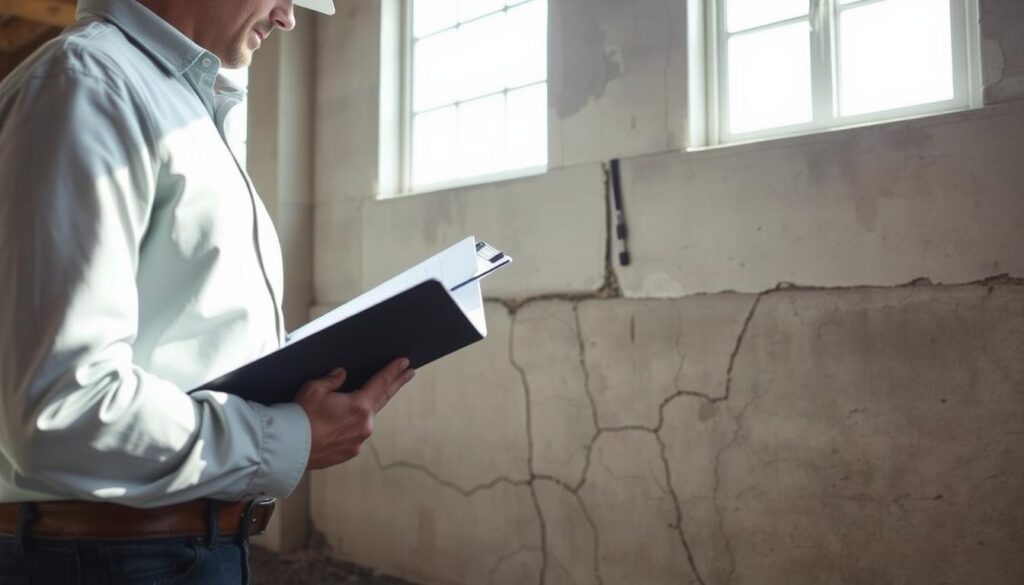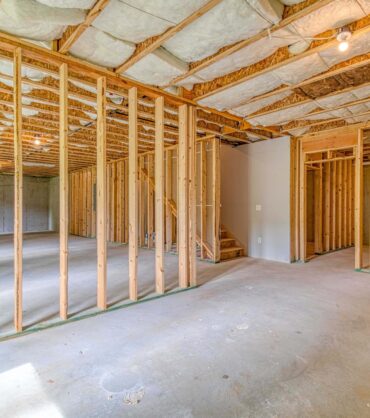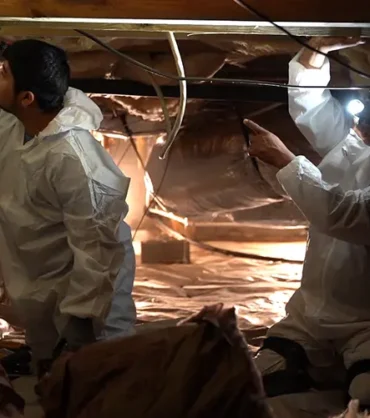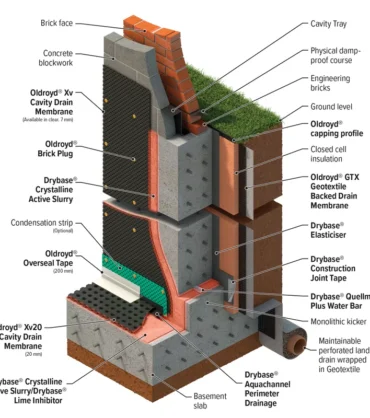It was a typical Saturday morning for Sarah in Rockville. She was cleaning her basement when she noticed a thin, jagged line snaking up the concrete wall. A wave of concern washed over her. Was this just a simple cosmetic flaw, or was it a sign of something more serious affecting her house’s stability?
Many homeowners in our area share this experience. We see it often in Washington, DC, North Bethesda, Manassas, and Ashburn. That initial discovery can be unsettling. You might wonder about water leaks, shifting soil, or the safety of your biggest investment.
We want to put your mind at ease. Those imperfections in your basement walls are common. They can happen for many reasons, like normal settling or temperature changes. While some small issues might be a quick weekend project, others need a professional eye to ensure your property’s long-term health.
Our guide is here to walk you through it all. We’ll help you understand what you’re seeing and why addressing it promptly is so important for protecting your house’s value and safety. We believe in clear, friendly communication so you feel confident in every decision.
Key Takeaways
- Discovering issues in your basement walls is a common concern for homeowners.
- These imperfections can stem from various causes, including soil pressure and settling.
- Prompt attention is crucial to prevent potential water damage and maintain your property’s stability.
- Understanding the severity of the issue helps in deciding between a DIY approach and professional help.
- Our team offers expert guidance and services across the Washington, DC metro area.
- We provide 24/7 support at 1-833 888 2533 for immediate assistance.
Understanding Foundation Cracks and Their Impact
When inspecting your basement, you’ll likely encounter several distinct patterns in the walls that require different levels of attention. Recognizing these variations helps you understand what’s happening beneath your home.
Common Causes and Types of Cracks
Different wall imperfections tell different stories. Vertical lines often appear during normal settling and concrete curing. They’re typically less than 1/8 inch wide.
Horizontal markings suggest more serious concerns. They may indicate pressure from water-saturated earth pushing against your wall. Diagonal lines often result from uneven settling.
Stair-step patterns commonly appear in block construction. They follow the mortar joints in a stepped fashion.
| Type | Appearance | Common Causes | Severity Level |
|---|---|---|---|
| Vertical | Straight up/down lines | Concrete shrinkage, settling | Low to Moderate |
| Horizontal | Side-to-side lines | Soil pressure, water force | High |
| Diagonal | Angled lines | Uneven settling, soil shift | Moderate to High |
| Stair-step | Stepped pattern | Moisture issues, settling | Moderate |
| Shrinkage | Thin vertical/diagonal | Concrete curing process | Low |
How Cracks Affect Structural Integrity
These wall imperfections can impact your home’s stability in various ways. Some merely affect appearance while others compromise safety.
Water seepage through openings can lead to moisture problems. This may cause mold growth and damage stored items. Significant shifts can affect door and window operation.
Monitoring changes over time is crucial. Mark the ends with pencil and date them. Watch for widening or new directions.
Assessing Structural Integrity and Evaluating Damage
Finding unexpected lines or gaps in your basement can prompt concerns about your home’s structural health. We understand this uncertainty and want to help you distinguish between minor cosmetic issues and serious structural integrity problems.

Proper evaluation begins with recognizing different severity levels. Each type of imperfection tells a story about what’s happening beneath your home.
Minor, Moderate, and Severe Crack Indicators
We categorize wall issues into three main severity levels. Minor cracks foundation problems are typically less than 1/4 inch wide without water leakage. These usually don’t immediately threaten your home’s integrity.
Moderate issues involve openings greater than 1/4 inch, often with water seepage. Severe damage shows significant wall movement or structural changes that demand immediate attention.
| Severity Level | Width | Water Presence | Recommended Action |
|---|---|---|---|
| Minor | Less than 1/4 inch | No leakage | Monitor and seal |
| Moderate | 1/4 inch or wider | Possible seepage | Professional assessment |
| Severe | Varies with movement | Active leaking | Immediate professional help |
When to Seek Professional Help
Contact our 24/7 support center at 1-833 888 2533 when you notice multiple cracks foundation issues or active water intrusion. Warning signs include walls bulging, floors sloping, or gaps wide enough to fit a dime.
We believe early professional evaluation prevents minor issues from becoming major structural integrity concerns. Don’t hesitate to reach out when you’re uncertain about any damage to your home’s stability.
Our Step-by-Step Foundation Crack Repair Process
Many people wonder about the actual process professionals use to fix structural issues. We’ve developed a systematic approach that ensures durable, long-lasting results for your property.

Our method combines professional techniques with careful attention to detail. Each phase builds upon the previous one for comprehensive results.
Preparing the Surface and Voids
We begin by filling any hollow spaces within the foundation wall. Using triple-expanding foam creates a stable backing that prevents material from falling through.
The foam application requires holding the can upside down. We carefully insert the nozzle into the void without overfilling. After about 10 minutes of curing time, the foam provides ideal support.
Widening Cracks and Applying Mortar
Next, we carefully open the imperfection to about 1/4 to 3/8 inch width. This allows the mortar to achieve proper adhesion with the concrete.
We mix the mortar with water and an acrylic bonding agent in precise proportions. Using a drill with mixing paddle ensures thorough blending for optimal consistency.
Before applying the material, we prepare the area by removing excess foam. Dampening the surface prevents the concrete from absorbing moisture too quickly.
Finishing Touches for a Durable Repair
We force the mortar deep into the opening using a margin trowel. Packing it tightly throughout the entire depth ensures structural integrity.
After smoothing the surface flush with the surrounding wall, we allow it to set for 15 minutes. Light scrubbing creates a textured finish that matches the existing surface.
The final curing period lasts two weeks before painting. This complete process addresses both visible issues and underlying concerns in your foundation wall.
Tools, Materials, and Safety Best Practices
Proper tools and materials separate temporary fixes from permanent solutions for your home’s stability. We want you to understand the equipment professionals use and why safety comes first in every project.

Essential equipment includes basic hand tools and specialized materials. You’ll need a cold chisel, hammer, mixing tools, and trowels for surface work. Triple-expanding foam and mortar mixes create durable results.
Essential Tools and Repair Materials
Professional methods often involve injection systems for deep penetration. These techniques ensure complete filling of voids in concrete structures.
We primarily use two material types for different situations. Each serves a specific purpose in restoring wall integrity.
| Method | Primary Use | Material Properties | Application Rate |
|---|---|---|---|
| Polyurethane Foam Injection | Non-structural sealing | Expands to fill voids, flexible | 90-95% of cases |
| Epoxy Injection | Structural reinforcement | Rigid, stronger than concrete | 5-10% of cases |
| Carbon Fiber Systems | Wall reinforcement | 10x stronger than steel | With epoxy only |
Low-pressure injection works best for concrete applications. It requires less equipment while providing thorough coverage.
Important Safety Precautions
Safety glasses and work gloves protect against debris and abrasions. Proper ventilation is crucial when using expanding foam products.
Always follow manufacturer instructions for all materials. Secure your workspace to prevent accidents during projects.
Taking preventive measures helps avoid future issues. Maintain drainage and monitor soil moisture around your property.
Local Support and Contact Details for Immediate Assistance
Quick access to professional help ensures minor issues don’t escalate into major problems for homeowners. We understand that concerns about your home’s foundation walls need prompt attention.
Water intrusion or visible damage to basement walls requires expert evaluation. Our local presence across the region means we can respond quickly when cracks appear.
24/7 Call Support Center: 1-833 888 2533
We’re available around the clock because structural concerns don’t keep business hours. Call our support line any time of day or night.
Our experts can provide immediate guidance over the phone. They help you determine the urgency of your situation.

Our Service Area Locations
We maintain multiple offices throughout the Washington metro area. Each location serves specific communities with tailored expertise.
| Location | Address | Services Focus |
|---|---|---|
| Washington, DC | 2315 Wisconsin Ave NW, Washington, DC 20007 | Urban property foundation walls and water management |
| Rockville, MD | 330 N Stonestreet Ave, Unit S, Rockville MD, 20850 | Comprehensive assessment and repair services |
| North Bethesda, MD | 5014 Nicholson Ln, Rockville, MD 20852 | Regional soil condition solutions |
| Manassas, VA | 10748 Sudley Manor Dr, Manassas, VA 20109 | Northern Virginia structural integrity |
| Ashburn, VA | 44121 Leesburg Pike Unit 170, Ashburn, VA 20147 | Water damage prevention and foundation walls |
How to Write to Us: info@dmvwp.com
Email provides a convenient way to share photos and details about your concerns. Our team responds promptly with personalized recommendations.
Don’t wait for small signs to become significant problems. Contact us through any channel that works best for your schedule.
Conclusion
Maintaining your property’s integrity requires both immediate action and long-term preventive strategies. We’ve shown you how to distinguish between minor issues you can handle yourself and serious concerns needing professional repair attention.
Proper drainage, vegetation control, and consistent soil moisture management are key to preventing future problems. These simple steps protect your home from water damage and soil pressure over time.
Our team stands ready 24/7 at 1-833 888 2533 to assist with any concern about your concrete foundation. Whether you spot a new crack or want a comprehensive inspection, we serve Washington, DC, Maryland, and Virginia with expert care.
FAQ
What are the most common types of foundation cracks we see?
We often encounter vertical, horizontal, and stair-step cracks in block or concrete walls. Vertical fissures are frequently caused by normal settling, while horizontal or diagonal ones may signal pressure from soil or moisture issues that need immediate attention.
How can a small crack affect my home's structural integrity?
Even minor cracks can allow water and moisture to seep in, leading to damage over time. They can weaken the wall and, if left unaddressed, may widen, indicating more serious underlying problems with the soil or foundation system.
When should I be concerned about a crack and call for professional help?
We recommend seeking our assistance if you notice cracks wider than 1/4 inch, those that are actively leaking water, or any horizontal fissures. These signs often point to issues that require expert evaluation and a durable repair process to prevent future damage.
What materials do you use for repairs, like epoxy or polyurethane foam?
We select the best material for each situation. For structural strength, we might use epoxy injection. To seal active leaks and stop water, we often employ flexible polyurethane foam. The right choice depends on the crack type and your home's specific needs.
What does your step-by-step repair process involve?
Our method starts with a thorough assessment. We then prepare the area, clean and widen the fissure if needed, and apply the appropriate mortar or injection material. The final step involves finishing the surface to ensure a long-lasting solution that restores integrity.
How can I prevent future cracks from forming?
Managing moisture around your home is key. We advise maintaining proper drainage, ensuring downspouts direct water away from the walls, and keeping the soil grade consistent. These steps help stabilize the ground and reduce pressure on your foundation.



![[GetPaidStock.com]-680786795b816 [GetPaidStock.com]-680786795b816](https://dmvwp.com/wp-content/uploads/2025/04/GetPaidStock.com-680786795b816-370x418.jpg)

![[GetPaidStock.com]-682c400c87c15 [GetPaidStock.com]-682c400c87c15](https://dmvwp.com/wp-content/uploads/2025/04/GetPaidStock.com-682c400c87c15-370x418.jpg)

![[GetPaidStock.com]-682c413fa898e [GetPaidStock.com]-682c413fa898e](https://dmvwp.com/wp-content/uploads/2025/03/GetPaidStock.com-682c413fa898e-370x418.jpg)